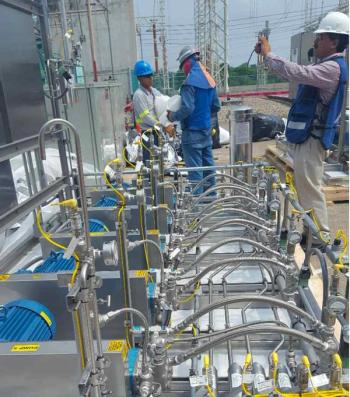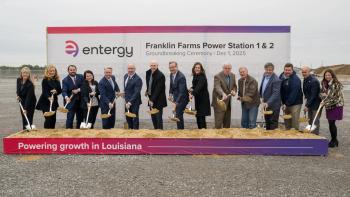
The Big Picture in Gas Turbine Upgrades
BEFORE GREEN LIGHTING A GT UPGRADE, IT IS WISE TO DETERMINE THE IMPACT ON THE HEAT RECOVERY STEAM GENERATOR AND BALANCE OF PLANT EQUIPMENT
Combustion turbine upgrades often prove to be an economical path to add capacity and flexibility to a combined cycle facility or fleet. From aeroderivatives to large-frame machines, nearly all gas turbine OEMs provide upgrade packages for all sizes of turbines.
GE, for example, has recently emphasized turbine upgrades for the GE 7FA gas turbine fleet to increase the maximum output of the engine. While the advantages in terms of projected overall capacity increase are obvious, it takes some investigation and analysis to determine the impact on the Heat Recovery Steam Generator (HRSG) and Balance of Plant (BOP) equipment.
This is particularly important with modern three-pressure reheat HRSGs as the interactions between the different systems and their original design limits can be difficult to assess.
Nearly every combustion turbine upgrade changes the amount of energy available for heat recovery. The change may be due to increased exhaust mass flow, higher exhaust temperature, a different mixture or composition of exhaust products or a combination of the three. Even modifications that do not result in a significant change to the overall exhaust energy (i.e., more mass flow at a lower temperature or vice versa) may have an impact on the HRSG. This is due to the fact that the HRSG was specifically designed based on the original predicted turbine exhaust gas conditions.
Changes to the exhaust stream have different impacts on different machines. Conceptualizing the impact on each section of a modern three-pressure-withreheat HRSG is difficult as the interactions between the systems can be challenging to reconcile without a computer model.
Accurate performance modeling tools are needed to fully understand the implications. Further, a computer model can be tuned to the as-performing condition of the HRSG and performance shortfalls can be identified to more accurately predict the net change after the upgrade.
Let us take a look at each part of the system and find how turbine upgrades can change the expected performance.
Superheaters
Superheaters are designed to take saturated steam and increase the temperature well above the saturation temperature to raise steam turbine performance (Figure 1). Superheaters are most affected by changes to the exhaust temperature. Due to the cost of tube and header alloys that are suitable for high design temperatures and pressures, most OEMs minimize the “extra margin” when finalizing tube selection.
If the boiler design code calculation states a minimum thickness of 0.150” for the design conditions and the metallurgy, the OEM most likely provided a 0.150” minimum wall tube.
Often the numbers do not work out quite so nicely; the calculation may require a 0.145” wall tube, but the standard tube thickness that meets this requirement is 0.150” minimum wall. In this case, the OEM would likely provide the 0.150” minimum wall tube rather than ordering a specialized mill run, thus have some extra margin in the design.
Evaporators
Evaporators serve to generate steam from a feedwater supply stream. The amount of heat transfer surface area is selected to provide a specified amount of steam generation at a set of design conditions. In units with duct burners, the steam generation is usually defined by the fired conditions.
When a turbine is modified, the evaporator may generate more steam than it did originally, particularly if duct burners are fired to the same duty. In this scenario, it is possible to exceed the rated steaming capacity of the unit. Thus proper precautions to limit duct firing must be implemented.
Units without duct burners were not designed for an increase in steam flow above that predicted in the lowest ambient full load case since there is not a mechanism (duct burner) to increase the energy to the system. As a result, a turbine upgrade that increases capacity may require reduced load operation or turbine runbacks in certain conditions. Rerating the HRSG, and any modifications dictated by the rerating evaluation, may be required in these situations.
The rated capacity of the boiler is typically established by the highest predicted steamflow conditions, and the safety relief valves are sized for this flow. Often it is possible to allow an increase in the capacity of the system by changing out a valve orifice or adjusting the set pressure. However, additional aspects must be checked when increasing steaming capacity comes into play:
- Pressure part thickness — The increase in steaming capacity increases the flow, thus the pressure drop through the system, raising superheater, evaporator and economizer operating pressure. Therefore the original pressure part code calculations may need to be checked
- Steam drum internals —The steam separation equipment in the drums (both primary separators, such as baffle plates and cyclones) as well as secondary or final separators (commonly chevron or mesh agglomerators) are at risk of poor performance when the capacity of the system is increased (Figure 2). This in turn can lead to carry-over and other issues.
Economizers
Economizers are not immune to concerns caused by changes to the turbine exhaust profile. While they are not at risk of overheating like superheaters, other performance issues can occur.
One common issue is economizer steaming. This is a phenomenon that occurs when the exhaust gas entering the economizer is hot enough to cause some of the water in the economizer to vaporize or steam.
In panelized economizers, steaming can be managed by appropriate economizer vent operation. Return bend economizers, however, are not ventable and steaming results in reduced thermal efficiency as circuits become “vapor-locked” at the upper return bends.
Attemperators
Attemperators (also called desuperheaters) are devices used to control the final temperature of a steam path. If a turbine upgrade causes an increase in exhaust temperature, or an increase in exhaust mass flow while maintaining the same temperature, the attemperator for a given system will be required to spray more water into the steam to maintain the same outlet temperature (Figure 3).
If the control valve or attemperator nozzles were previously on the edge of acceptable performance, the change in operation due to the gas turbine upgrade can result in an inability to control the final temperature. Even if the valves and nozzles are sized suitably for the increased flow, there may not be enough energy in the steam to completely vaporize the spray water injected into the system.
Unvaporized spray water creates thermal stress risk to downstream piping, headers and tubes. Another concern is Flow Accelerated Corrosion (FAC) risk in the spray water supply line. FAC risk varies with temperature, chemistry and shear force. Typical spray water lines operate at the peak temperature for FAC risk so even a moderate increase in flow may put the spray water line into the FAC danger zone.
Other pieces of equipment outside the casing of the HRSG are also affected by turbine upgrades. Condensate and feedwater pumps may have been sized without enough margin, so an increase in flow or pressure may not be suitable for the pump.
Feedwater control valves also come into play in the water supply capacity and should be reviewed to ensure adequate capacity or turndown is available. Ancillary equipment such as emissions controls devices (catalyst, ammonia vaporizers, and ammonia pumps) may need modification to provide adequate service after the upgrade. The condenser should also be checked to confirm it is sized appropriately for any increase in demand after the upgrade.
System analysis
Combustion turbine upgrades are often an economical way to increase capacity and operational flexibility. However, it is prudent to perform engineering analysis on the overall system to make an informed decision on the upgrade.
When shortcomings are identified, engineering solutions to address the issues can be pursued. Even if no shortcomings are identified, the peace of mind that “something bad” is not going to happen to the boiler as a result of the upgrade is valuable. It is very possible to purchase a turbine upgrade or modification and only later realize the HRSG limits the benefit of the investment. Such a course leads to a bitter taste for the plant owner or operator as well as a potential black eye for the combustion turbine OEM.
Case Studies
A client recently requested HRST to model the effects of GE’s Advanced Gas Path (AGP) upgrade on their three-pressure-withreheat HRSG. HRST data analysis and performance modeling revealed that the existing HRSG had overperforming superheaters and reheaters.
The turbine upgrade would cause them to absorb even more heat. This in turn required even greater amounts of attemperating spray flow. Since the unit required spray flow even at current base load, HRST recommended the installation of tube shields to reduce the effective surface area for heat transfer in these sections (Figure 4).
Besides the benefit of reduced spray flow, the modification allows the plant to generate slightly more HP steam than without the tube shields. The performance model determined the quantity of tube shields that met the performance requirements at the new base load.
Finally, we confirmed that with both the tube shields and turbine upgrade, relying on attemperating flow to control the steam temperature at other operating conditions was achievable.
Another facility is considering AGP and a turbine upgrade to allow lower gas turbine loads. In this arrangement, the IP section of the boiler (and to a lesser extent, the LP section) generates more steam than the original design conditions.
The IP safety valves and steam separation equipment were sized appropriately for the additional steam flow, however the nameplate capacity was exceeded. This fact required a boiler rerate to allow operation at the increased flow conditions presented by the AGP upgrade.
The low-load-upgrade analysis showed an increase in spray flow such that the existing attemperator control valves were undersized. The plant could opt to replace the valves or trim to allow more flow or allow the final steam temperature to float higher than the current setpoint (up to 1,060°F from 1,050°F). With these relatively easy HRSG modifications understood, HRST expects the plant to implement the AGP modification.
Written by: Jonathan Aurand is Analysis Manager at HRST, a company specializing in the inspection, analysis and upgrade of existing gas turbine HRSGs. Its engineers, designers and technical advisors tackle inspections, problem investigations and design upgrades on over 200 HRSGs per year worldwide. For more information, visit www.hrstinc.com or call/email (952) 767 8100, WHO@hrstinc.com.
Newsletter
Power your knowledge with the latest in turbine technology, engineering advances, and energy solutions—subscribe to Turbomachinery International today.





